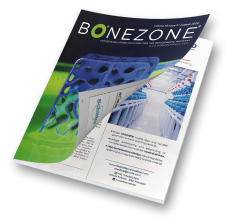
Growth in the arthroscopy and soft tissue repair market is propelled by surgeon requests for devices that employ muscle- and tissue-sparing techniques to return patients to activity faster and with less pain. This is largely being driven by patients in this segment, particularly athletes and “weekend warriors,” who are making more decisions about their care.
Companies in this space will need to equip surgeons with the tools they seek to meet this trend, bearing in mind patient outcomes and costs, though price pressure is not as high in this segment as other orthopaedic markets.
BONEZONE spoke with four device companies, ranging from early-stage to large player, that are responding to these surgeon and patient trends in a number of ways. Some are launching and refining diverse product portfolios to cover a range of procedures, while others are focusing on specific clinical needs. Surgeons and companies say that some biologics are gaining greater traction as potential treatment options, as well.
Simplification continues to be an interest expressed by surgeons, says Scott Schaffner, Vice President of Sports Medicine at Smith & Nephew, the second-largest player in the segment behind Arthrex.
“If there are ways to spare anatomy, we obviously want to do it in the least disruptive way possible,” he says. “The ultimate goal is to continue to improve outcomes. There are a lot of wonderful procedures within sports medicine today, but everyone acknowledges room for improvement.”
Despite advancements, some procedures still pose challenges for surgeons, such as cases associated with diseases and complex injuries like rotator cuff and meniscus repairs.
Two companies that BONEZONE spoke with noted the challenges of treating the meniscus.
Ceterix Orthopaedics launched the NovoStitch® Plus Meniscal Repair System in 2015, which enables placement of a circumferential compression stitch around the meniscus. The system incorporates a pre-loaded suture implant, intended to ease use and cut the number of procedure steps by more than half.
John McCutcheon, President and CEO of Ceterix, emphasizes the importance of repairing the meniscus, rather than performing a meniscectomy, which he notes is under scrutiny as a treatment for meniscus repair.
McCutcheon is seeing surgeons push to do repairs for more types of injuries that they used to think were irreparable, like radial tears.
“More and more surgeons say, ‘Look, we’ve got to repair everything,’ ” McCutcheon says. “The data supports what we’re doing. More data is coming out that a meniscectomy is not a good thing—payors and providers are paying attention. All of the literature and data on repairs shows that [repairing the meniscus] prevents arthritis later and that it’s the right thing to do, so that’s been good for us.”
Active Implants is also focused on developing alternative treatments for the meniscus. The company’s NUsurface® meniscus implant, the first “artificial meniscus” designed to replace one that is damaged or deteriorating, is currently in its investigational stage in two clinical trials, SUN and VENUS, in the U.S.
The NUsurface is designed to be used in patients who had a partial meniscectomy, and now have persistent knee pain, but aren’t ready for total or partial knee replacement, says Adam Klyce, Vice President of Marketing & Communications, U.S. at Active Implants.
“There’s a giant pool of patients who had surgery that didn’t yield the result they wanted, and they don’t want the next surgery that’s available because [joint replacement is] too big,” Klyce says. “This aims to fill that treatment gap. It fits in between the injections/non-operative care and joint replacement.”
Klyce says that meniscectomy as a standalone procedure is under attack scientifically and economically.
“Having an artificial meniscus available in the market in a year or two will help to fill that gap. The gap is getting bigger, because the evidence and support for the current index procedure is going down,” he says.” If you have a meniscus tear and go to your doctor, and he says, ‘I would have done a meniscectomy on the knee but now, for reimbursement reasons and medical necessity, that’s going to be harder to do.’ ”
Rotator cuff repairs can pose challenges for surgeons as well, as the procedures are associated with high revision rates, Schaffner says.
“[Rotator cuff repair] is a great procedure, but we still acknowledge there are way too many revisions and cases that aren’t successful,” he says. “Everyone acknowledges that there’s room for improvement. There’s an appetite for technologies and techniques that can help with that.”
Smith & Nephew emphasized its shoulder repair portfolio, which includes a suture passer, anchor and suture tape for rotator cuff procedures, at the 2016 AAOS Annual Meeting.
“It’s a host of products that can stand on their own individually, but the way we’re positioning them is as a solution that gives surgeons options to address various anatomical challenges or pathologies,” Schaffner says. “They can tailor those different tools and combine them as a solution for rotator cuff repair.”
Offering a broad product portfolio may serve companies well, says Brian Cole, M.D., a sports medicine and cartilage restoration orthopaedic surgeon at Midwest Orthopaedics at Rush University Medical Center in Chicago, Illinois.
“Given the nature of hospital systems, broad product platforms are a potentially dominant strategy amongst device companies versus narrow technology platforms,” Cole says. “Those
that cross boundaries—not just the device, but things that enable you to use the device—and having technology that surrounds a core device platform, with capital equipment and so forth, can make a big difference. It’s difficult to differentiate certain devices based on their own merits, but when you’re taking the context of a family of products from a device company, the decisions are made a little differently, by the clinical doctors and decision makers in how that device gets in the hands of a surgeon.”Part of that product platform could be orthobiologics, such as stem cells, which are an emerging a potential treatment option as surgeons seek to augment the body’s natural healing process. However, there is mixed feedback on the use of orthobiologics in the segment.
“Several recent studies have shown that augmenting the single- or double-row rotator cuff repair with bone marrow aspirate, stem cell injections or marrow stimulation can reduce re-tears or re-ruptures significantly, especially for larger tears,” says Lester Fehr, Vice President of Global Marketing & Strategic Partnerships at Arthrosurface.
Fehr is seeing “an increased push for orthobiologics, such as stem cell-based offerings and implants that are minimally invasive and provide a more anatomic or custom fit” from surgeons.
Arthrosurface offers the NanoFx® Microfracture system, a biological preliminary treatment for pain relief for patients experiencing the beginning stages of arthritis and/or cartilage damage.
Cole has seen an uptick in the use of allograft to treat cartilage problems and to augment soft tissue repair to treat the inflammatory process related to osteoarthritis. He has also seen an increase in the employment of stem cells.
“The benefits of stem cells are largely due to their anti-inflammatory effects, potential to augment healing from surgical procedures and the ability to modulate the immune system,” he says. “They might be anti-pain. They can promote healing and they can harness the body’s ability to heal and potentially regulate, allowing our bodies to capitalize on an inherent desire to heal after injury or trauma. The reality is that the clinical utilization still exceeds the clinical research.”
During a presentation at the 2016 AAOS Annual Meeting, Ken Yamaguchi, M.D., an orthopaedic shoulder and elbow surgeon at Washington University Orthopedics in St. Louis, Missouri, discussed the challenges of treating the rotator cuff.
Yamaguchi is skeptical about the use of orthobiologics for rotator cuff repairs, saying, “Biological enhancements are still far away. There is some evidence they improve healing, but I think future studies will show they don’t.”
Yamaguchi thinks that genetic sequencing is going to be common within one to two years for rotator cuff disease, due to the genetic basis of the ailment.
Lack of consensus and data on the success and potential of these orthobiologic solutions is a barrier to approval in hospitals and recognition from payors. Orthobiologics are often associated with no or low reimbursement, which has impacted their adoption by companies.
Schaffner says that Smith & Nephew is keeping its eye on any breakthroughs in the area of orthobiologics, though it’s not in the company’s immediate focus for these procedures.
McCutcheon is not focused on orthobiologics either, at the moment, finding it an unlikely match for Ceterix’s meniscus tear solution.
“One exception might be if the patient already had advanced arthritis,” McCutcheon says. “That might change the chemistry in the knee, and maybe at that point they would need some biologic enhancement, but we’re seeing great results with no biologics, as long as the cartilage is well preserved.”
Cole argues that patients paying out of pocket who seek novel treatments to manage their pain may drive more demand for orthobiologics.
“When patients are bearing risk, the cost is often inversely related to the level of desperation or impairment by the patient,” he says. “There are some relatively rare conditions, or even common conditions, where the level of pain and impairment in the eyes of the patient is sufficiently high and their desire to avoid other traditional therapies is significant, so they’re willing to pay out of pocket, more than they otherwise would be, with the hopes that they’ll achieve some clinical benefit.”
Send comments on this article to Carolyn LaWell.





